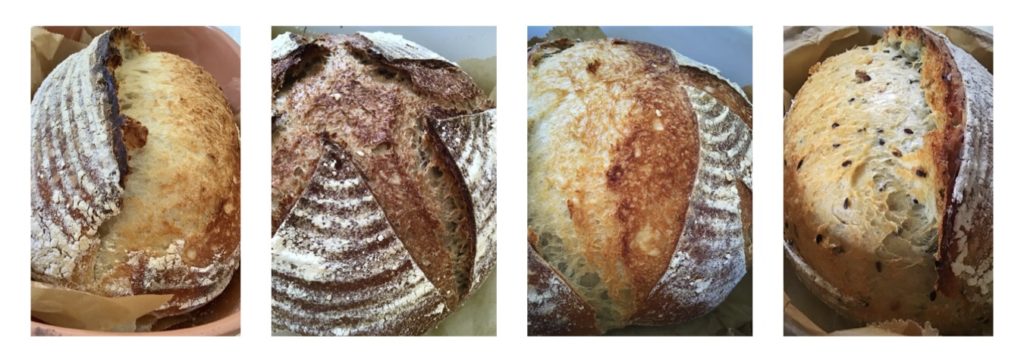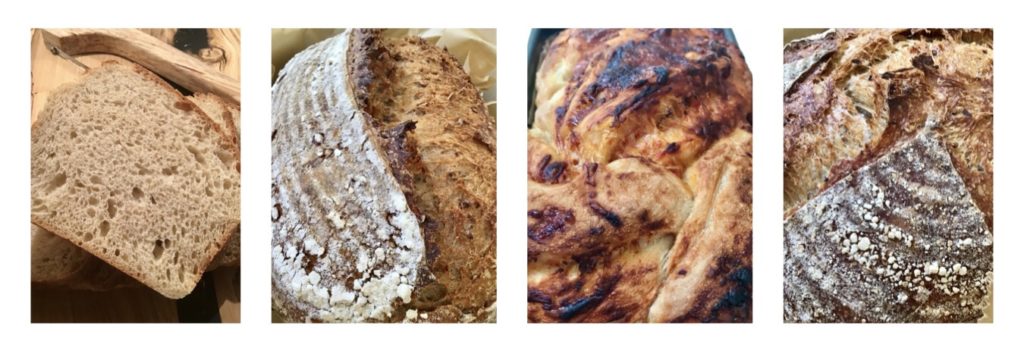
Who knew what the reality of lockdown would be?
Who really had any idea?
I know I didn’t.
For us, my husband continued to work, being considered a key worker, and my 18 year old son’s school life and A level exams suddenly got completely wiped out. But for me, I work for myself, I work from home anyway, so I didn’t foresee much difference…except for having the added extra of my son’s lovely company every day…
How wrong I was; I have literally lived through one of the busiest, if not THE busiest, periods of my life.
Let me explain: I set this website up a couple of years ago to share my process for making sourdough simply, successfully, and consistently, for anyone who wanted to make it at home. I see and read so many over complicated recipes, numerous processes with unnecessary and excessive steps, and I knew it didn’t need to be so hard and so seemingly inaccessible, so I decided to build this website and to share my process and tips with anyone who might be interested. I was already sharing my loaves on Instagram and people seemed to like them, so I set up my Facebook page and then my group, to chat and to share more of what I was doing.
I had no idea if there would be any interest, I thought I would share my sourdough world with my friends and family, and that would be it. But the interest in sourdough has been building over the last few years and my audience has grown along the way and I now have a whole lovely extended family of ‘foodbodders’. It’s been amazing, and a source of great joy to be able to help people all over the world to make great healthy tasty homemade bread.
Enter lockdown. And that level of interest went supernova! On an average day during lockdown I have answered hundreds, no exaggeration, literally hundreds, of messages, emails and comments per day.
And why? Because during lockdown the interest in making sourdough grew exponentially. I think there are several reasons this happened; suddenly people who have always wanted to give it a go had the time, then others saw what they were doing, and saw the press stories, and fancied having a go and got involved too. Supplies of commercial yeast also run dry so people were looking for alternatives and making a sourdough starter and generating your own yeast became the perfect answer.
And with that comes questions and feedback and cries for help. Sourdough has a magical capacity to turn minds to jelly at the best of times, add in the heightened emotions of the Covid 19 situation, and insecurities for some sourdough newcomers were even greater than would normally have been. At the same time flour shortages hit, so that threw in more confusion and a lot of questions about different flours and alternative options. The beauty of this though is that it gave people the chance to try flours they may have never used otherwise, as well as learning just how different the outcome of sourdough can be depending on the flour you use.
For a sourdough lover like me, lockdown has been an amazing time. It has been a joy to see so many people getting involved and being able to share this amazing joy from my kitchen to theirs. Sourdough saved so many peoples’ sanity during a time of such uncertainty; it gave people a chance to see how you can take the basics of flour and water and make a starter, the positivity of nature and creation, as well as the timely reassurance of renewal and growth. They enjoyed watching their starters come to life in front of their eyes; it’s been a welcome reminder that life goes on. They also enjoyed the welcome distraction of looking after their starters, creating their doughs and producing their loaves.
I’ve been sent photos of loaves baked using my process during lockdown from every corner of the globe; the excitement when people unveil their first loaves is palpable. And it’s enabled them to create their own heathy, homemade bread to enjoy with their families and share with others. People have told me about local virtual baking groups they’ve created, family and friends’ sourdough WhatsApp groups, how they have been sharing their starters, doing produce swaps for flours, baked loaves for their families and neighbours, provided bread for vulnerable isolated neighbours. It’s been infectious, as much because sourdough is so rewarding, but also it’s a satisfying, fulfilling process. It’s something people can get lost in and excited about, and we all needed some of that during lockdown.
The other question I’m asked is this: do I think the interest will continue once restrictions lift and people go back to work?
And my answer is: I truly hope so. Lockdown enabled people to start making sourdough from scratch, and gain experience whilst they had the time. And that doesn’t need to stop.
Sourdough is the healthiest form of bread we can eat, making our own means we know exactly what is in it, and those benefits and that joy can continue. It can also easily be made during a working week. So yes, I think the interest will continue and I hope that people enjoy their new found interest and skill and happy baking!
But the point of this post is about how sourdough has helped peopled through such an unprecedented uncertain time. For me, I’ve been too busy to think; I haven’t had time to dwell on things, I haven’t had time to worry, plus it’s made time fly. I’ve talked to people all over the world daily, shared sourdough help as well as lockdown stories. Between helping others and looking after my home and family, I haven’t had time to be scared. It’s been a gift in so many ways.

So how about you? How has sourdough helped you through lockdown?
I’d love you to comment and share your experiences and build a living diary of our sourdough lockdown experiences. It may prove to be inspirational, even cathartic, or just interesting to see read others’ experiences.
Below are some stories from just a few of my bakers that you may find sound familiar to your experiences…
“Baking in general has always been a form of therapy for me. However, these last few weeks it has proven to be a life-saver or rather a “sanity-saver”. Sourdough baking with its processes, feeding and folds is something I can get lost in and something I can be a part of. I can control nearly everything happening in my loaf and that grounds me. Something else it has shown me (although I already knew this) is that my favourite part of baking is sharing. Sourdough has become an integral part of my life, one that brings me happiness and comfort, specially these last weeks.”
Aranzazu García Tomás, English teacher from Zaragoza, Spain
“My sourdough journey started last October, I was laid up after having an op on my foot. I was totally immobile so I started browsing ‘sourdough starters’ and baking sourdough bread, and there started my addiction. I spent two weeks reading and watching everything about sourdough, and when I could hobble around, I thought I’d give it a go.
Suffice to say it’s been an up and down journey, my first two loaves stuck so much to the pot I had to soak them in water to get the ‘bread’ out, I say bread, it was inedible.
But I persevered and it’s now a passion beyond anything I’ve done before.
Sourdough grounds me, the whole process, feeding my starter, watching it rise, mixing the dough and then the magic happens in the oven. I’m a mental health worker in the NHS, the lockdown has had a huge impact in my line of work, mental health of the nation has really suffered. So to come home, start a loaf, whether we need one or not is my way of putting the work day down. For me, sourdough is almost ‘ mindful’ it grounds me and brings me back to what I love about making sourdough bread, it’s a joy and has kept me sane during lockdown. Of course another side of the coin is my work colleagues love it as they see the fruits of my labour, it’s a win win scenario in tough times. I feel truly blessed, especially currently to have not only the ability to make bread but to have to sourdough community which has been a huge help during lockdown.
Sourdough is now a way of life for me, shop brought bread is a thing of last year and never to come into my home. I make delicious, wholesome bread at home, it may not always win the beauty contest for looks but who cares?
Some people close to me having jokingly said I’m “obsessed” with sourdough, I’d like to call it passionate, whatever it may be , I don’t care as long as I’m baking sourdough, I’m happy.”
Kal Tace, Community Support Worker, Nottingham
“Sanity saving sourdough in lockdown. Three months ago this would have given me pause, before I began research into their meaning. Now after living with this since March 5, 2020 I understand much too well. Spending most of those three months alone has been much harder than one could appreciate at the outset. I am a retired critical care RN of nearly 40 years. I take care of people and make them better. I am a mother of three and “Nan” to 1 grandson. Suddenly I had to stay at home to stay safe-virus free. My sourdough starter, Olivia, was born December 10, 2018 and help me produce many loaves of wonderful bread for my children(all in their 30’s). I could still bake bread for them and arrange transport… or so I thought.
With the panic of jobs closing, people forced to stay home and schools closing there was also a ‘panic buying’of cleaning products, masks, toilet paper and flour! This is when I became actually frightened. Sourdough bread was important to how I take care of my family now. I realized I could still bake, but I must be smart. I could still produce bread for my kids and myself, but only perhaps once a week. I could still feed my starter, Olivia and drink in the sweet sour smell and watch her bloom over a few hours. I could still mix Olivia into a beautiful stretchy dough and let them work together under my guidance. The touch and smell of this dough kept my feet on the ground. Eventually, after much searching, I was able to find bread flour to order that did not come in 100 pound bags! I ordered my flower, but it still took three anxious weeks to come, or maybe a bit longer. What a wonderful day that was when that flour came!
Perhaps one of the biggest pieces of my sanity anchors, besides making my bread, is the Facebook group I’ve been inspired by- Sourdough with foodbod. I lurked in the shadows a bit and became so inspired by so many sourdough bakers from all over the world. Elaine Boddy and all her moderators are there to help and inspire! That is what a lockdown baking community should be- inspiration and how to continue baking in our new normal.”
Lesley Fuson, Nashville, Tennessee, USA
Please read on in the comments to read Kristen’s fabulous story and then do please add your own…let’s build our own living history of how sourdough has helped us through lockdown and show the world how wonderful this sourdough world of our is…
Please note that your comment will not show immediately; it is not lost, check back in a little while and it will show up.
